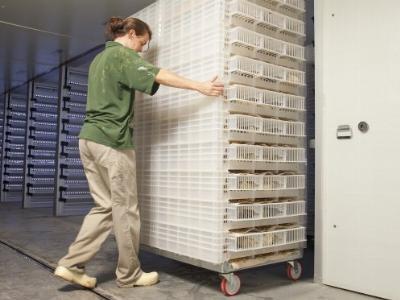Effects of post-hatch brooding temperature on broilers

Intensive broiler production comes with challenges for animal welfare, including lameness and contact dermatitis, which may inflict pain and complicate performance of behavioural activities like, e.g. foraging.
Besides welfare problems, lameness and contact dermatitis are of economical concern due to culling, on-farm mortality, and costly down-grading of the carcass. Another welfare and economic concern is the prevalence of non- and slow-starters.
An elevated brooding temperature during the first week post hatch of broilers may potentially increase activity levels and reduce welfare problems in terms of non- and slow-starters, lameness, and contact dermatitis. Photo: Bart Nijs
Non-starter broiler
Broilers are incapable of sustaining normal body temperature without an external source of heat until about 10 d of age and are at risk of getting under-cooled if no metabolic heat production occurs as a result of feeding. In general, non-starter broilers will lie down and cluster together to restore heat. This prevents feeding, and non-starter broilers will eventually die.
Slow-starter broiler
In slow-starter broilers, initiation of feeding post hatch is delayed, which may result in reduced body weight uniformity in the flock at slaughter age. Non- and slow-starters are most common among broilers originating from young parent breeders or when brooding temperature is poorly managed.
Broilers from young parent breeders
Broilers originating from young parent breeders usually have a smaller yolk sac, which shortens the time they can stay alive without feeding. Further, broilers originating from young parent breeders also have been reported to have a lower body weight in the entire growth period compared to broilers originating from older parent breeders. The effect of an elevated brooding temperature on behaviour, welfare, and growth of broilers was investigated. In addition, it was studied whether broilers differing with regard to hatching weight and age of parent breeders were affected differently by brooding temperature.
Temperature management
An elevated brooding temperature during the first week post hatch of broilers may potentially increase activity levels and reduce welfare problems in terms of non- and slow-starters, lameness, and contact dermatitis. The effects of an elevated brooding temperature the first 7 d post hatch on behaviour, welfare, and growth of Ross 308 broilers were investigated.
Groups of 28 broilers (14 males and 14 females) were distributed in a balanced way according to their hatching weight (below or above mean), the age of parent breeders (28 or 50 wk of age), and initial brooding temperature (normal 33◦C; warm: 37◦C) resulting in eight different treatment groups. Behavioural data, data on body weight, and data on gait and contact dermatitis were collected. The welfare of broilers may be improved from an elevated brooding temperature the first 7 d post hatch without affecting body weight uniformity and final body weight.
Có thể bạn quan tâm
 Cooling-pad maintenance tips to relieve bird heat stress
Cooling-pad maintenance tips to relieve bird heat stress Regular maintenance of your poultry house’s evaporative cooling system is the best way to maximize the temperature drop across the pads and maintain bird
 ‘Better Life’ standard a healthy choice
‘Better Life’ standard a healthy choice Broiler farmers Tienus and Alie Berkepies switched from regular broiler production to Better Life standard (‘Beter Leven’ – 1 star) at the beginning of 2017.
 Poultry red mites are Europe’s most costly poultry pest
Poultry red mites are Europe’s most costly poultry pest This tiny blood sucking arachnid is found in many countries and is very difficult to eliminate from infested farms.
 Calculating additional resource needs in cage-free
Calculating additional resource needs in cage-free Cage-free egg production requires additional manpower and feed, but exactly how much? Experts offer their estimates.
 Black soldier fly meal may boost growth, survival of broilers
Black soldier fly meal may boost growth, survival of broilers Broiler chickens on a diet with black soldier fly larvae may out-perform birds on a commercial feed, and survive longer in the face of a disease challenge